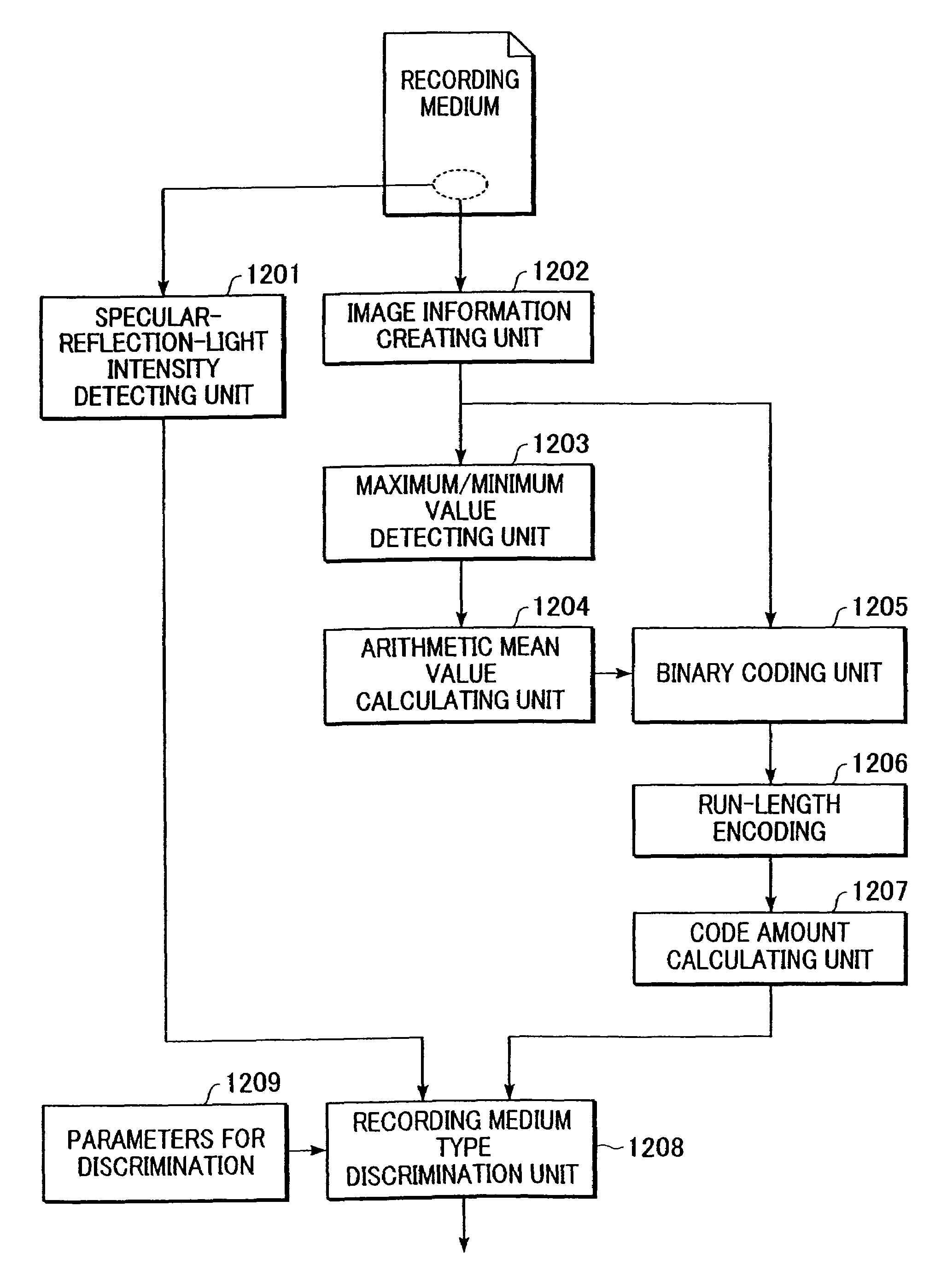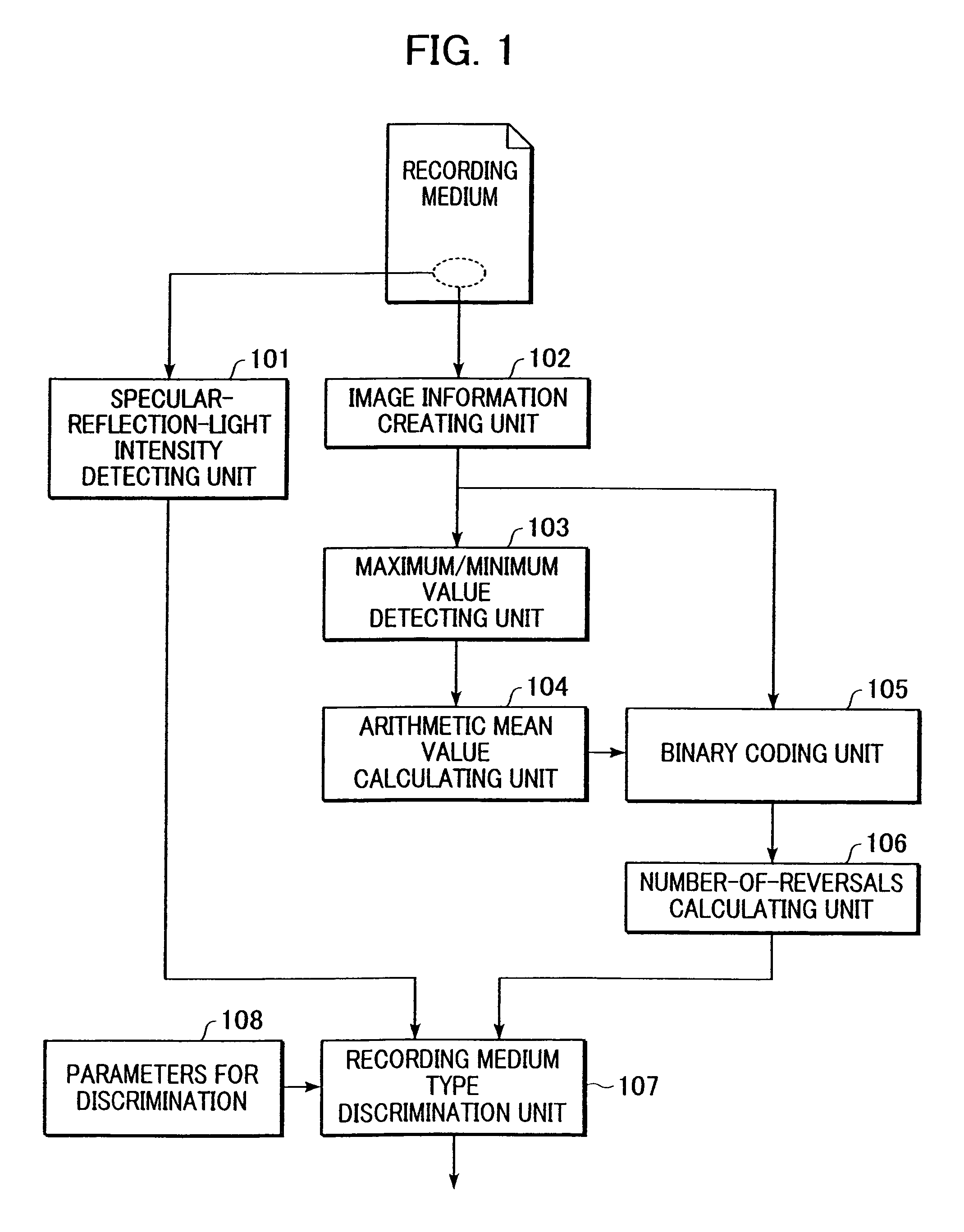Recording medium discriminating method and recording apparatus
a discriminating method and recording medium technology, applied in the direction of digitally marking record carriers, digital output to print units, instruments, etc., can solve the problems of inability to obtain the quality demanded by users in some cases, difficulty in accurately and the related art described above, etc., to achieve the effect of improving the accuracy of discriminating between photographic glossy paper and glossy film relationships
- Summary
- Abstract
- Description
- Claims
- Application Information
AI Technical Summary
Benefits of technology
Problems solved by technology
Method used
Image
Examples
first embodiment
(First Embodiment)
[0072]A first embodiment implementing the present invention will be described below in detail with reference to the drawings. Each of the elements shown in block outline in the figures is well known per se, and a specific type of construction is not critical to carrying out the invention or to a disclosure of the best mode for carrying the invention.
[0073]FIG. 1 is a functional block diagram showing a recording medium discriminating method according to a first embodiment of the present invention.
[0074]Referring to FIG. 1, a specular-reflection-light intensity detecting unit 101 detects the intensity of one component of reflected light from a surface of a recording medium, which is illuminated by a light source, i.e., the intensity of a specular reflection light having reflected at an angle of reflection equal to an angle of incidence is detected.
[0075]An image information creating unit 102 creates image information from an arbitrary small area of the recording medi...
second embodiment
(Second Embodiment)
[0152]A second embodiment implementing the present invention will be described below in detail with reference to the drawings.
[0153]While in the first embodiment the type of the recording medium is discriminated using the intensity of the specular reflection light and the number of reversals after the binary coding, a recording medium discriminating method of this second embodiment discriminates the type of the recording medium by using the intensity of the specular reflection light and a run-length code amount.
[0154]FIG. 12 is a functional block diagram showing the recording medium discriminating method according to the second embodiment.
[0155]A specular-reflection-light intensity detecting unit detects the intensity of one component of reflected lights from a surface of a recording medium, which is illuminated by a light source, i.e., the intensity of a specular reflection light having reflected at an angle of reflection equal to an angle of incidence is detecte...
third embodiment
(Third Embodiment)
[0183]A third embodiment implementing the present invention will be described below in detail with reference to the drawings.
[0184]A recording medium type discriminating method realizing this third embodiment is featured in discriminating the type of the recording medium based on the intensity of the specular reflection light and the number of isolated pixels. A process flow and a discrimination flow are substantially the same as those in the first embodiment, and hence a description thereof is omitted here.
[0185]FIG. 17 is a functional block diagram showing the recording medium discriminating method according to the third embodiment.
[0186]A specular-reflection-light intensity detecting unit 1701 detects the intensity of one component of reflected lights from a surface of a recording medium, which is illuminated by a light source, i.e., the intensity of a specular reflection light having reflected at an angle of reflection equal to an angle of incidence is detected...
PUM
| Property | Measurement | Unit |
|---|---|---|
| brightness | aaaaa | aaaaa |
| gloss level | aaaaa | aaaaa |
| gloss | aaaaa | aaaaa |
Abstract
Description
Claims
Application Information
 Login to View More
Login to View More - R&D
- Intellectual Property
- Life Sciences
- Materials
- Tech Scout
- Unparalleled Data Quality
- Higher Quality Content
- 60% Fewer Hallucinations
Browse by: Latest US Patents, China's latest patents, Technical Efficacy Thesaurus, Application Domain, Technology Topic, Popular Technical Reports.
© 2025 PatSnap. All rights reserved.Legal|Privacy policy|Modern Slavery Act Transparency Statement|Sitemap|About US| Contact US: help@patsnap.com



